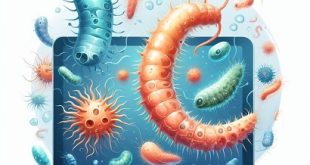ژیاردیا لامبلیا یک انگل تک یاخته ای است که می تواند روده کوچک انسان را آلوده کرده و باعث اسهال، سوء جذب و سایر علائم گوارشی شود. ژیاردیا لامبلیا دارای دو شکل مورفولوژیکی است: تروفوزوئیت و کیست. این اشکال ساختار و عملکرد متفاوتی در چرخه زندگی انگل دارند.
مروری بر مورفولوژی ژیاردیا
تروفوزوئیت
تروفوزوئیت شکل فعال و متحرک ژیاردیا لامبلیا است که در روده کوچک زندگی و تکثیر می شود.
- دارای بدنه گلابی یا راکت تنیس شکل با انتهای قدامی پهن و انتهای خلفی باریک تر است.
- طول تروفوزوئیت ۹-۲۱ میکرومتر و عرض آن ۵-۱۵ میکرومتر است.
- سطح پشتی تروفوزوئیت محدب است، در حالی که سطح شکمی مقعر است و دارای یک دیسک مکنده (بادکش) دارد که به انگل کمک می کند تا به سلول های اپیتلیال روده متصل شود.
- تروفوزوئیت دارای دو هسته است که هر یک دارای یک کاریوزوم مرکزی بزرگ است.
- تروفوزوئیت همچنین دارای چهار جفت تاژک است که در دو گروه قدامی، دو گروه جانبی و دو گروه خلفی قرار گرفته اند. تاژک ها به حرکت تروفوزوئیت و شنا در مجرای روده کمک می کنند.
- تروفوزوئیت دارای دو جسم میانی است که ساختارهای منحنی و عرضی هستند که در پشت دیسک مکنده قرار دارند. اجسام میانی منحصر به ژیاردیا لامبلیا هستند و عملکرد آنها به طور کامل شناخته نشده است.
- تروفوزوئیت همچنین دارای دو آکسواستایل است که ساختارهای میله مانندی هستند که از قسمت قدامی به انتهای خلفی انگل گسترش می یابند. آکسواستایل ها در تقسیم سلولی نقش دارند و همچنین نقش محافظتی از انگل را دارند و شکل تروفوزئیت را حفظ می کنند.
- سیتوپلاسم تروفوزوئیت یکنواخت و دانه بندی ریز است و حاوی اندامک های مختلفی مانند میتوکندری، شبکه آندوپلاسمی، دستگاه گلژی و ریبوزوم است.
- تروفوزوئیت نوع خاصی از حرکت “برگ در حال سقوط” را نشان می دهد، جایی که به طور متناوب می چرخد و در امتداد سطح مخاطی می لغزد.
- تروفوزوئیت دهان یا سیستم گوارشی واقعی ندارد و مواد مغذی را از طریق غشای پلاسمایی خود از میزبان جذب می کند.

کیست
کیست شکل خفته و عفونی ژیاردیا لامبلیا است که از طریق مدفوع دفع می شود و می تواند چندین هفته یا چند ماه در محیط زنده بماند.
- تخم مرغی شکل یا بیضی است و طول آن حدود ۸-۱۲ میکرومتر و عرض آن ۷-۱۰ میکرومتر است.
- کیست دارای ۲ یا ۴ هسته است.
- در داخل کیست علاوه بر هسته ها بقایای تاژک ها، اکسواستیل و اجسام سپر مانند (Shields) دیده می شود.
- کیست توسط یک دیواره ضخیم احاطه شده است که از انگل در برابر شرایط سخت محافظت می کند و به آن کمک میدهد در برابر ضد عفونی کننده ها و کلر زنی مقاومت کند.

لینک دانلود اسلاید های عملی ژیاردیا
پیشنهاد مطالعه مطالب مشابه
Giardia lamblia is a protozoan parasite that can infect the human small intestine and cause diarrhea, malabsorption, and other gastrointestinal symptoms. Giardia lamblia has two morphological forms: the trophozoite and the cyst. These forms have different structures and functions in the life cycle of the parasite.
Trophozoite
The trophozoite is the active and motile form of Giardia lamblia that lives and multiplies in the small intestine. It has a pear-shaped or tennis racket-shaped body with a broad anterior end and a tapering posterior end.
- The trophozoite measures about 9-21 micrometers in length and 5-15 micrometers in width.
- The dorsal surface of the trophozoite is convex, while the ventral surface is concave and has a sucking disc (also called an adhesive disc) that helps the parasite attach to the intestinal epithelial cells.
- The trophozoite has two nuclei, each with a large central karyosome that gives the parasite a face-like appearance in stained preparations.
- The trophozoite also has four pairs of flagella that are arranged in two anterior, two lateral, and two posterior groups. The flagella help the trophozoite move and swim in the intestinal lumen.
- The trophozoite shows a characteristic “falling leaf” type of motility, where it alternately rotates and glides along the mucosal surface.
- The trophozoite has two median bodies, which are curved and transverse structures that lie behind the sucking disc.
- The median bodies are unique to Giardia lamblia and their function is not fully understood.
- The trophozoite also has two axostyles, which are rod-like structures that extend from the anterior to the posterior end of the parasite. The axostyles are involved in cell division and may also provide some support to the parasite.
- The cytoplasm of the trophozoite is uniform and finely granulated, and contains various organelles such as mitochondria, endoplasmic reticulum, Golgi apparatus, and ribosomes. The trophozoite does not have a true mouth or digestive system, and absorbs nutrients from the host through its plasma membrane.
Cyst
The cyst is the dormant and infective form of Giardia lamblia that is excreted in the feces and can survive in the environment for several weeks or months.
- The cyst is oval or ellipsoidal in shape and measures about 8-12 micrometers in length and 7-10 micrometers in width.
- The cyst is surrounded by a thick cyst wall that protects the parasite from harsh conditions and allows it to resist disinfectants and chlorination.
 انگل شناسی پزشکی Medical Parasitology
انگل شناسی پزشکی Medical Parasitology





